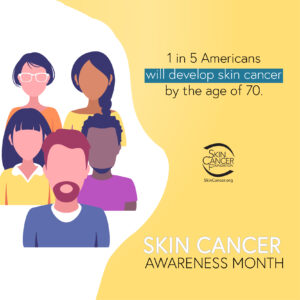Skin Cancer Awareness Month: Protect Your Skin, Protect Your Life
May is Skin Cancer Awareness Month. It’s a crucial time to focus on skin health and preventing skin cancer. Skin cancer is the most common cancer in the United States. Therefore, spreading awareness about its risks, prevention methods, and early detection is essential. This blog will provide you with key tips and information to keep your skin safe and healthy.
Understanding Skin Cancer
Skin cancer occurs when skin cells grow abnormally. This is often due to DNA damage from ultraviolet (UV) radiation. UV radiation comes from the sun or tanning beds. There are three main types of skin cancer:
- Basal Cell Carcinoma (BCC): This is the most common type. It usually appears as a waxy bump or a flat lesion.
- Squamous Cell Carcinoma (SCC): This type often looks like a firm, red nodule or a flat, scaly lesion.
- Melanoma: This is the most dangerous form. It can develop in existing moles or appear as a new dark spot.
Risk Factors
Everyone is at risk for skin cancer. However, some factors increase your risk:
- Excessive Sun Exposure: Especially without protective clothing or sunscreen.
- Tanning Beds: These are a significant risk factor, particularly for young people.
- Fair Skin: Less melanin means less natural protection.
- History of Sunburns: Particularly blistering sunburns in childhood.
- Family History: Genetics play a role.
- Immune System Suppression: Certain conditions and medications increase risk.
Prevention Tips
Preventing skin cancer starts with protecting your skin. Here are some practical tips:
- Apply Sunscreen Daily: Use a broad-spectrum sunscreen with at least SPF 30. Reapply every two hours and after swimming or sweating.
- Wear Protective Clothing: Long-sleeved shirts, wide-brimmed hats, and sunglasses offer additional protection.
- Seek Shade: Especially between 10 AM and 4 PM when the sun’s rays are strongest.
- Avoid Tanning Beds: They are as harmful as direct sun exposure.
- Perform Regular Skin Checks: Examine your skin monthly for new or changing moles or spots. Use the ABCDE rule to assess moles:
- Asymmetry: One half doesn’t match the other.
- Border: Irregular, scalloped, or poorly defined edges.
- Color: Varied from one area to another.
- Diameter: Larger than 6mm (about the size of a pencil eraser).
- Evolving: Changes in size, shape, or color.
Early Detection Saves Lives
Early detection of skin cancer increases the chances of successful treatment. If you notice any suspicious changes, see a dermatologist immediately. Dermatologists can conduct professional skin exams and perform biopsies if necessary.
How Your Esthetician Can Help
Your esthetician can play a vital role in the early detection of skin cancer. Here’s how they can help:
- Regular Skin Exams: During facials and other treatments, estheticians examine your skin closely. They can spot unusual changes, such as new moles or lesions.
- Educating Clients: Estheticians can educate you about the importance of skin cancer prevention and signs to watch for.
- Referral to Dermatologists: If your esthetician notices something suspicious, they can recommend that you see a dermatologist for further evaluation.
Build a relationship with your esthetician by having regular treatments, this can add an extra layer of vigilance in monitoring your skin health.
Conclusion
Taking care of your skin is not just about beauty—it’s about health. When you understand the risks of skin cancer and take proactive steps to protect your skin, you can significantly reduce your risk. This May, let’s commit to being vigilant about our skin health.
Stay sun-safe and informed!
For more information and resources, visit the Skin Cancer Foundation and the American Academy of Dermatology.
Remember: Protect your skin today for a healthier tomorrow. Call us today to schedule your next appointment or book online at www.privyskincare.com




